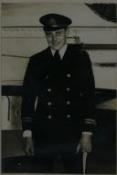
War Memorial
| Captain Alexander KEILLER | |
|
Royal Naval Volunteer Reserve and Royal Air Force Date of birth: 1st December 1889 Date of death: 29th October 1955 Died aged 65 Unknown |

|
| Alexander Keiller was born at Binrock House, Dundee on the 1st of December 1889 the son of Alexander Keiller, a manufacturer of preserves, and Elizabeth Keiller of Morven, Ballater in Aberdeenshire. He was the heir to the family marmalade business of James Keiller & Sons of Dundee; his father died when he was nine years old, leaving him as the sole heir to the business. He was educated at Hazelwood School until July 1903 when, on leaving the school, the magazine wrote of him: - "....goes to Eton. he has not been able to take a prominent part in the field, but has been a great help on the stage." He went on to Eton College where he was in Mr J.H.M. Hare's House from September 1903 to July 1907. He served as a Private in the Eton Rifles. On leaving school he went to run the family business following the death of his mother. He was commissioned as a 2nd Lieutenant in the 7th (Deeside Highland) Battalion Gordon Highlanders on the 1st of October 1909 and was promoted to Lieutenant on the 6th of May 1911. He resigned his commission on the 8th of October 1913. He was married to Florence Marianne (nee Phil-Morris) on the 2nd of June 1913 and they moved to London. Later in 1913 he founded, financed, and was a director of the Sizaire-Berwick Motor Company which produced motor cars which resembled the Rolls Royce. Following the outbreak of war he was commissioned as a temporary Lieutenant in the Royal Naval Volunteer Reserve on the 11th of October 1914 for service with the Royal Naval Air Service and was posted to HMS Pembroke on the same day after which he served with the Armoured Car Section. He was promoted to Lieutenant on the 9th of November 1914 and was posted to HMS President in early 1915. He transferred to the Royal Naval Air Service on the 27th of June 1915 with the rank of Acting Flight Lieutenant and served at Chingford until the 12th of July 1915. He learnt to fly at the Royal Naval Air Station, Chingford and obtained his Aero Certificate (2132) on the 27th of November 1915 flying an Avro biplane. On the 23rd of December 1915 he attended a medical examination which concluded that he was unfit for service and required him to attend a further examination at the Admiralty on the 24th of January 1916. This medical concurred with the earlier findings and he left the service a short time later. He returned to work for his old firm. On the 29th of July 1918 he re-joined the service with the rank of Lieutenant in the Technical Branch (Air Intelligence) of the Royal Air Force where he served until the end of the war being promoted to Temporary Captain and to Staff Officer Grade 3 on the 23rd of September 1918. He retired to the Unemployed List on the 15th of April 1919 with the rank of Acting Captain. After the war he was divorced and began to pursue an interest in archaeology. In 1922 he and Osbert Guy Stanhope Crawford undertook an aerial survey of archaeological sites in South West England. In 1925 he purchased the land on which was the great monument of Avebury dating from 1,500 BC in the early Bronze Age. The settlement had been inhabited and contained the earliest example of a domestic dog found in the UK. In 1928 he and Crawford published the book, "Wessex from the Air". He was re-married to Veronica Mildred (nee Liddell) on the 29th of February 1924 at the Church of the Assumption in Warwick Street, London and they moved to Windmill House near Avebury in Wiltshire. Following a period of separation they divorced in 1934. In 1937 he founded the Morven Institute of Archaeological Research where he met his third wife Doris Emerson (nee Chapman), an artist, whom he married on the 16th of November 1938. They lived at The Manor, Avebury. He was married once again to Gabrielle (nee Styles) in 1951 who donated the museum and its contents to the nation in 1966. His many excavations had to stop during the Second World War when he took up duties as a special constable at Marlborough. He mothballed his museum and transferred the land to the National Trust in 1943. He died at his home at Telegraph Cottage, Kingston Hill in Surrey. His life story was published under the title A Zest for Life: The Story of Alexander Keiller” by Lynda J. Murray. The Alexander Keiller Museum in Avebury is still open to the public today. |
|
 | |
| Went on to Eton College |
Back